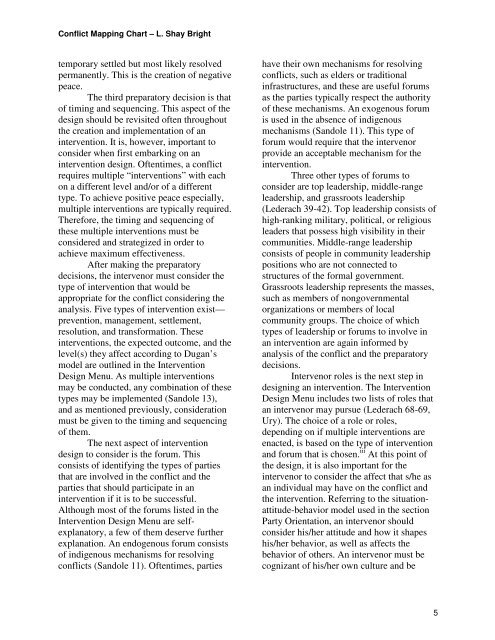The Conflict Mapping Chart By L. Shay Bright To ... - CMSupport.org
The Conflict Mapping Chart By L. Shay Bright To ... - CMSupport.org
The Conflict Mapping Chart By L. Shay Bright To ... - CMSupport.org
Create successful ePaper yourself
Turn your PDF publications into a flip-book with our unique Google optimized e-Paper software.
<strong>Conflict</strong> <strong>Mapping</strong> <strong>Chart</strong> – L. <strong>Shay</strong> <strong>Bright</strong><br />
temporary settled but most likely resolved<br />
permanently. This is the creation of negative<br />
peace.<br />
<strong>The</strong> third preparatory decision is that<br />
of timing and sequencing. This aspect of the<br />
design should be revisited often throughout<br />
the creation and implementation of an<br />
intervention. It is, however, important to<br />
consider when first embarking on an<br />
intervention design. Oftentimes, a conflict<br />
requires multiple “interventions” with each<br />
on a different level and/or of a different<br />
type. <strong>To</strong> achieve positive peace especially,<br />
multiple interventions are typically required.<br />
<strong>The</strong>refore, the timing and sequencing of<br />
these multiple interventions must be<br />
considered and strategized in order to<br />
achieve maximum effectiveness.<br />
After making the preparatory<br />
decisions, the intervenor must consider the<br />
type of intervention that would be<br />
appropriate for the conflict considering the<br />
analysis. Five types of intervention exist—<br />
prevention, management, settlement,<br />
resolution, and transformation. <strong>The</strong>se<br />
interventions, the expected outcome, and the<br />
level(s) they affect according to Dugan’s<br />
model are outlined in the Intervention<br />
Design Menu. As multiple interventions<br />
may be conducted, any combination of these<br />
types may be implemented (Sandole 13),<br />
and as mentioned previously, consideration<br />
must be given to the timing and sequencing<br />
of them.<br />
<strong>The</strong> next aspect of intervention<br />
design to consider is the forum. This<br />
consists of identifying the types of parties<br />
that are involved in the conflict and the<br />
parties that should participate in an<br />
intervention if it is to be successful.<br />
Although most of the forums listed in the<br />
Intervention Design Menu are selfexplanatory,<br />
a few of them deserve further<br />
explanation. An endogenous forum consists<br />
of indigenous mechanisms for resolving<br />
conflicts (Sandole 11). Oftentimes, parties<br />
have their own mechanisms for resolving<br />
conflicts, such as elders or traditional<br />
infrastructures, and these are useful forums<br />
as the parties typically respect the authority<br />
of these mechanisms. An exogenous forum<br />
is used in the absence of indigenous<br />
mechanisms (Sandole 11). This type of<br />
forum would require that the intervenor<br />
provide an acceptable mechanism for the<br />
intervention.<br />
Three other types of forums to<br />
consider are top leadership, middle-range<br />
leadership, and grassroots leadership<br />
(Lederach 39-42). <strong>To</strong>p leadership consists of<br />
high-ranking military, political, or religious<br />
leaders that possess high visibility in their<br />
communities. Middle-range leadership<br />
consists of people in community leadership<br />
positions who are not connected to<br />
structures of the formal government.<br />
Grassroots leadership represents the masses,<br />
such as members of nongovernmental<br />
<strong>org</strong>anizations or members of local<br />
community groups. <strong>The</strong> choice of which<br />
types of leadership or forums to involve in<br />
an intervention are again informed by<br />
analysis of the conflict and the preparatory<br />
decisions.<br />
Intervenor roles is the next step in<br />
designing an intervention. <strong>The</strong> Intervention<br />
Design Menu includes two lists of roles that<br />
an intervenor may pursue (Lederach 68-69,<br />
Ury). <strong>The</strong> choice of a role or roles,<br />
depending on if multiple interventions are<br />
enacted, is based on the type of intervention<br />
and forum that is chosen. iii At this point of<br />
the design, it is also important for the<br />
intervenor to consider the affect that s/he as<br />
an individual may have on the conflict and<br />
the intervention. Referring to the situationattitude-behavior<br />
model used in the section<br />
Party Orientation, an intervenor should<br />
consider his/her attitude and how it shapes<br />
his/her behavior, as well as affects the<br />
behavior of others. An intervenor must be<br />
cognizant of his/her own culture and be<br />
5


